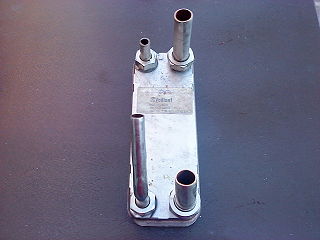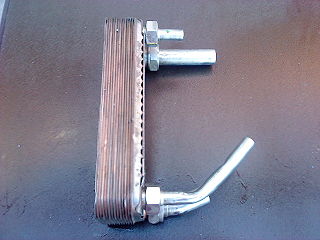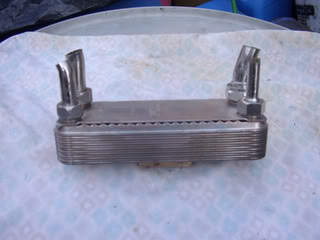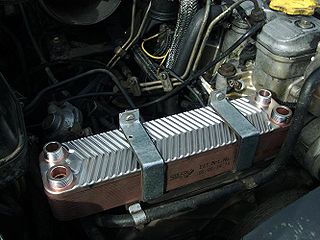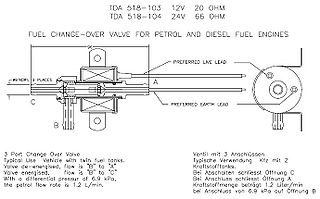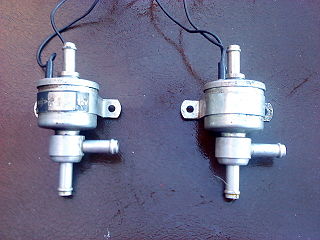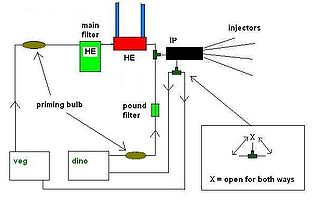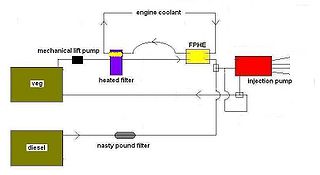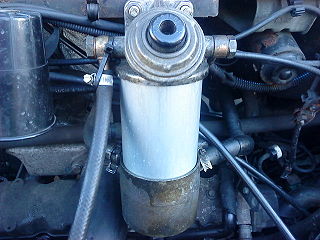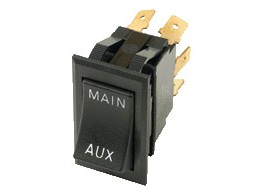Difference between revisions of "Heat exchangers and solenoid valves"
| (26 intermediate revisions by 3 users not shown) | |||
| Line 1: | Line 1: | ||
| + | <metadesc>Heat exchangers for vegetable oil, Solenoid valves for vegetable oil, Veg oil systems for car engines, Veg oil system diagram, WVO schematic, Running cars on cooking oil, Twin tank systems foe WVO, How to run a car on vegetable oil</metadesc> | ||
{{stub}} | {{stub}} | ||
| − | + | '''Twin-tank system.''' Parts and plumbing. | |
| − | The vehicle is started on mineral Diesel, and then the valves switch over to | + | The vehicle is started on mineral Diesel, and then the valves switch over to an auxiliary veg tank when the engine reaches full temperature - the heat exchanger is used to raise the temperature of vegetable oil before it reaches the injection pump, using engine coolant to transfer heat across the plates of the heat exchanger. |
| − | Before stopping the engine at the end of a journey, the system must be " | + | Before stopping the engine at the end of a journey, the system must be "Flushed or Purged" with mineral Diesel, making it safe to re-start ie: in the morning from a cold start few hours later. Short stops eg: 30 mins etc 99% of the time shouldnt need to purge/flush down, as the engine will still be upto optimum temperature. (winter times may vary!) |
| − | <gallery caption="Click pictures to enlarge" widths=" | + | <gallery caption="Click pictures to enlarge" widths="320px" heights="300px" perrow="2" align="center"> |
File:Heat1.JPG|This is a classic flat plate heat exchanger usually salvaged from an old combi boiler. | File:Heat1.JPG|This is a classic flat plate heat exchanger usually salvaged from an old combi boiler. | ||
| Line 15: | Line 16: | ||
File:Heat3.JPG|Easily plumbed into your car heater system using existing tails or by fitting 1/2 inch or 3/4 inch hosebarbs respectivly.These are readily available from oilbits in sizes to match your heater hoses ID. | File:Heat3.JPG|Easily plumbed into your car heater system using existing tails or by fitting 1/2 inch or 3/4 inch hosebarbs respectivly.These are readily available from oilbits in sizes to match your heater hoses ID. | ||
| − | File: | + | File:Fphe.jpg|Another FPHE, slightly different shape. |
| − | File:Valve12v2.JPG|12 volt valves. | + | File:Z007p.jpg|Heat exchanger fitted in a landrover 110. |
| + | |||
| + | File:Valve12v.JPG|Tecelamit 12 volt valves. | ||
| + | |||
| + | File:Twd.jpg|Wiring and plumbing diagram. | ||
| + | |||
| + | File:Valve12v2.JPG|Tecelamit 12 volt valves. | ||
| + | |||
| + | File:bgxcad4.jpg|One of a number of ways for plumbing in a twin tank system. | ||
| + | |||
| + | File:New-p.JPG|Twin tank system with heated filter and exchanger, plus a looped return to injection pump through heat exchanger. | ||
| + | |||
| + | File:Temp-sender-twin-looped.jpg|Twin tank system returning both fuels to there individual fuel tanks. | ||
| + | |||
| + | File:DSC00345.JPG|Bottom heated filter + fuel priming button on top , and like the peugeot filter can be modded by removal of the thermostat. | ||
| + | |||
| + | File:Filtside.jpg|Top heated filter ring. | ||
| + | |||
| + | File:Heat-ring.jpg|Heater ring that fits standard spin on cartridge type filters. | ||
| + | |||
| + | File:Temp_switch_T.jpg|Temperature sensor placed inline with a coolant hose on a car/van, which electrically switches to live at 60c changing fuel valves from diesel to vegetable oil. | ||
| + | |||
| + | File:SwitchVeg.jpg|Basic in-car switch for changeover from diesel to vegetable oil when optimum engine coolant temperature is reached avg: 80c. | ||
</gallery> | </gallery> | ||
| Line 23: | Line 46: | ||
[[User:Rotary-Motion|Rotary-Motion]] 21:50, 5 December 2010 (UTC) | [[User:Rotary-Motion|Rotary-Motion]] 21:50, 5 December 2010 (UTC) | ||
[[Category:Vegetable oil]] | [[Category:Vegetable oil]] | ||
| + | [[Category:Vehicles & modifications]] | ||
Latest revision as of 17:35, 26 January 2014
Twin-tank system. Parts and plumbing.
The vehicle is started on mineral Diesel, and then the valves switch over to an auxiliary veg tank when the engine reaches full temperature - the heat exchanger is used to raise the temperature of vegetable oil before it reaches the injection pump, using engine coolant to transfer heat across the plates of the heat exchanger.
Before stopping the engine at the end of a journey, the system must be "Flushed or Purged" with mineral Diesel, making it safe to re-start ie: in the morning from a cold start few hours later. Short stops eg: 30 mins etc 99% of the time shouldnt need to purge/flush down, as the engine will still be upto optimum temperature. (winter times may vary!)
- Click pictures to enlarge
Rotary-Motion 21:50, 5 December 2010 (UTC)
